Philodendron melanochrysum (black gold Philodendron) is a lovely, rare houseplant native to Colombia.
You will love its charming heart-shaped leaves that appear bronze as they emerge in young plants and the huge elongated dark green to almost black mature velvety leaves with golden specks and light green prominent veins.
Learn more on Philodendron melanochrysum, including care (soil, humidity, light, temperature, watering, etc.), propagation, and problems (pests, disease, leaves curling, drooping, turning yellow, brown, etc.).
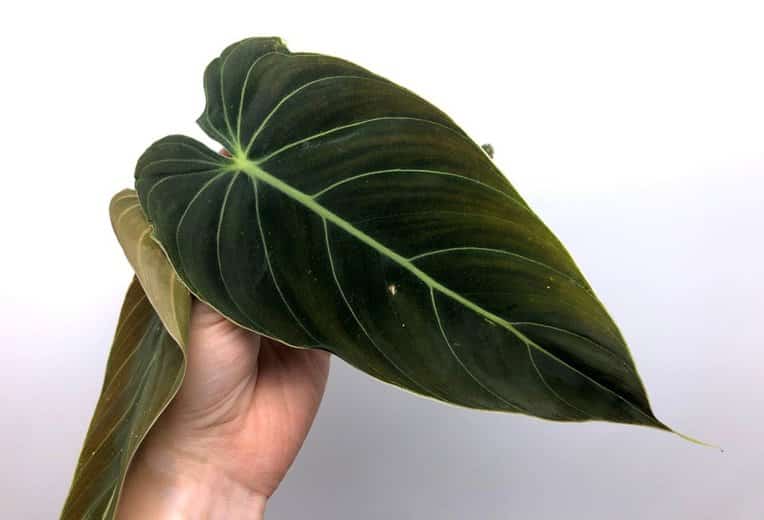
That is not all. We will tell you more about its hybrids (Philodendron melanochrysum x verrucosum and Philodendron melanochrysum x gloriosum. Also, we have something on prices, variegated form, and where to find it on sale. Of course, Etsy.com is the best place.
Contents
- Overview
- Description and appearance
- 1. Growing habits
- Growth rate and size
- Leaves
- 4. Stems
- 5. Flowers
- Philodendron melanochrysum hybrids
- 1. Philodendron splendid (Philodendron melanochrysum x verrucosum)
- 2. Philodendron Glorious
- Variegated Philodendron melanochrysum
- Philodendron melanochrysum vs. micans
- Philodendron melanochrysum care
- 1. USDA hardiness zone
- 2. Philodendron melanochrysum humidity
- 3. Temperature
- Light needs
- 5. Philodendron melanochrysum soil
- 6. Watering
- 7. Feeding
- 8. Pruning and grooming
- 9. Repotting
- 10. Staking or support
- Philodendron melanochrysum propagation
- 1. Soil propagation
- i. What you need
- ii. How to propagate Philodendron melanochrysum in soil
- 2. Water propagation
- 3. Air layering
- Problems
- 1. Pests
- 2. Diseases
- 3. Root rot
- 4. Other problems
- Where to find Philodendron melanochrysum on sale
- Frequently asked questions (FAQs)
Overview
- Scientific name: Philodendron melanochrysum
- Synonyms: Philodendron andreanum
- Common names: Black gold philodendron, Velour Philodendron, and Melano plant
- Family: Araceae (arum family or aroids)
- Native habitat: Colombia
- Toxicity: Toxic or poisonous to humans, cats, dogs, and other pets because it has insoluble calcium oxalates. These sharp crystals will cause an intense burning sensation and irritation if ingested. Also, the tongue, mouth, or lips may swell, and patients will have swallowing difficulties and no appetite. Other signs are drooling and mouth pawing for pets.
- Care level: Easy or low maintenance
The name melanochrysum is an epithet that means black gold and it describes the black golden speckles that mature leaves have when viewed in sunlight.
Description and appearance
Before telling cover hybrids care and where to buy, let us describe this plant’s appearance (leaves, stems, size, and flower). We will talk about growing habits.
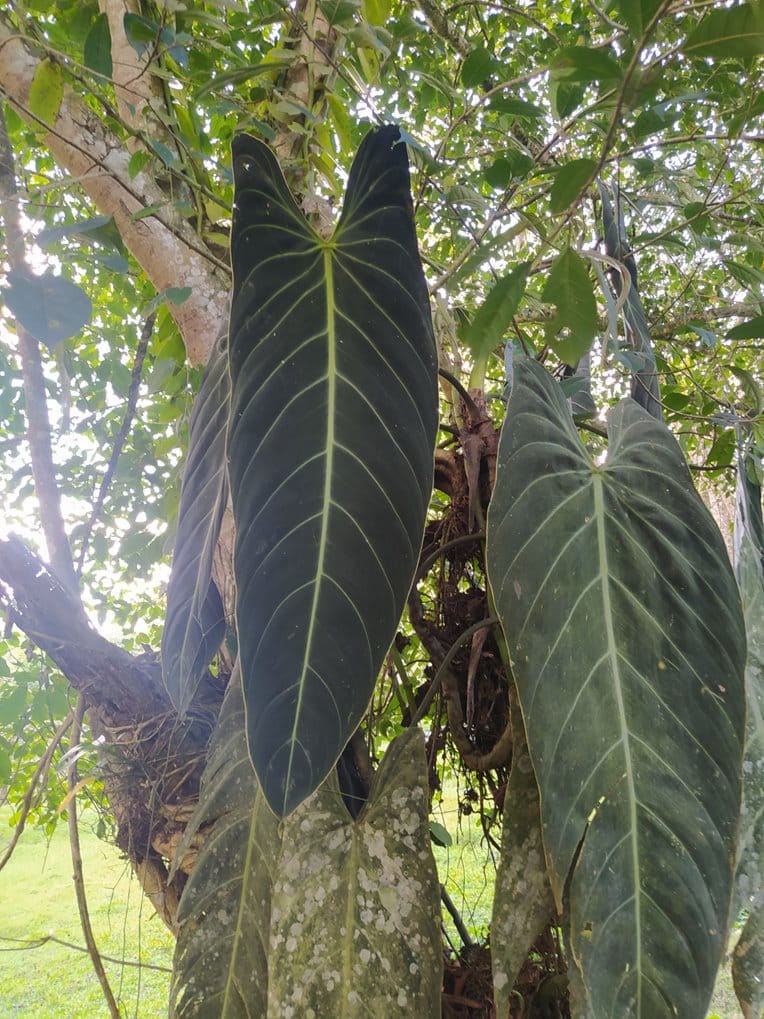
1. Growing habits
Philodendron melanochrysum is a vining evergreen flowering plant native to Colombia, with some collections made in Costa Rica, Ecuador, and Peru. It grows on the wet Andean foothills in Colombia at 1640 (500m) above sea level.
It grows as both a terrestrial and a climbing plant, i.e., the juvenile stage has smaller leaves and grows as a terrestrial creeper. But when it finds a place to climb, its leaf size, shape, and coloration change.
Growth rate and size
Philodendron melanochrysum has a slow to moderate growth rate, increasing by between 6 to 12 inches per growing season.
It can grow up to 20-26 feet (6-8 meters) if they have a climbing place in the wild. But at home, they will grow up to 6-8 feet tall and 1-2 feet wide. If you want to see those lovely large and elongated velvety leaves, provide it with a climbing place, at least 4-5 feet tall.
Leaves
Philodendron melanochrysum has lovely heart-shaped leaves that change in size and shape when the plant finds a place to climb.
In juvenile plants, the leaves are smaller (2 to 4 inches), broader, and have a bronze tone as they emerge. But sometimes, they may appear copper-red, salmon-red, or orange-brown.
On the other hand, mature Philodendron melanochrysum leaves are enormous and elongated, i.e., they can reach 36 inches (3 feet) or more. Also, they are velvety dark green to almost black, and when in sunlight, they will appear to have minute golden specks.
The other adorable thing about the black gold Philodendron leaves is the pale green veins that become more vivid in mature leaves.
Last but not least, petioles are erect, slightly shorter than the lamina, and have slight parallel grooves towards the upper end
4. Stems
Their climbing terete stems are slender, with 2.4-3.9 inches (6-10) cm long internodes and adventitious roots (aerial roots).
5. Flowers
Their inflorescence flowers have a spadix and a spathe. They aren’t conspicuous and hardly seen to bloom.
Philodendron melanochrysum hybrids
Besides the original plant, there are many melanochrysum hybrids. Common ones are:
1. Philodendron splendid (Philodendron melanochrysum x verrucosum)
This adorable cross of Philodendron melanochrysum and verrucosum has heart-shaped, dark green velvety leaves with bright, light green prominent veins. Some people refer to it as Philodendron andreanum x verrucosum. P. andreanum is just a synonym.
It borrows the velvety look from melanochrysum and bright light green prominent veins from verrucosum. But it isn’t as elongated as melanochrysum or broad as verrucosum.
If you need it, it goes for about $30 to $100. But if you want a cutting, you may get it at a much lower price.
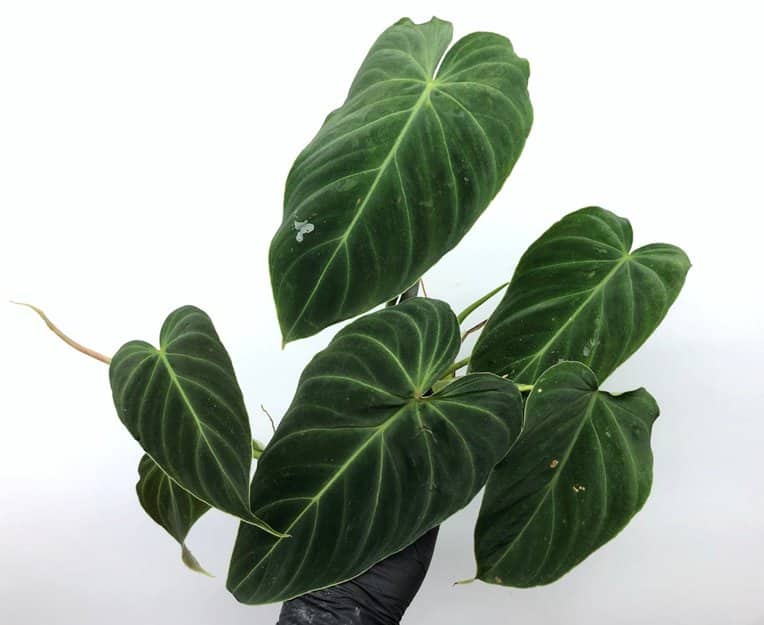
2. Philodendron Glorious
Philodendron glorious is another hybrid of Philodendron melanochrysum and Philodendron gloriosum with heart-shaped dark green leaves with light green veins.
Keith Henderson crossed it in Australia in the 1970s and has narrower leaves than gloriosum but not as elongated as melanochrysum.
To buy this Philodendron melanochrysum x gloriosum, be ready to part with about $100 to $200. Also, note that it is rare to find even with this heft price.
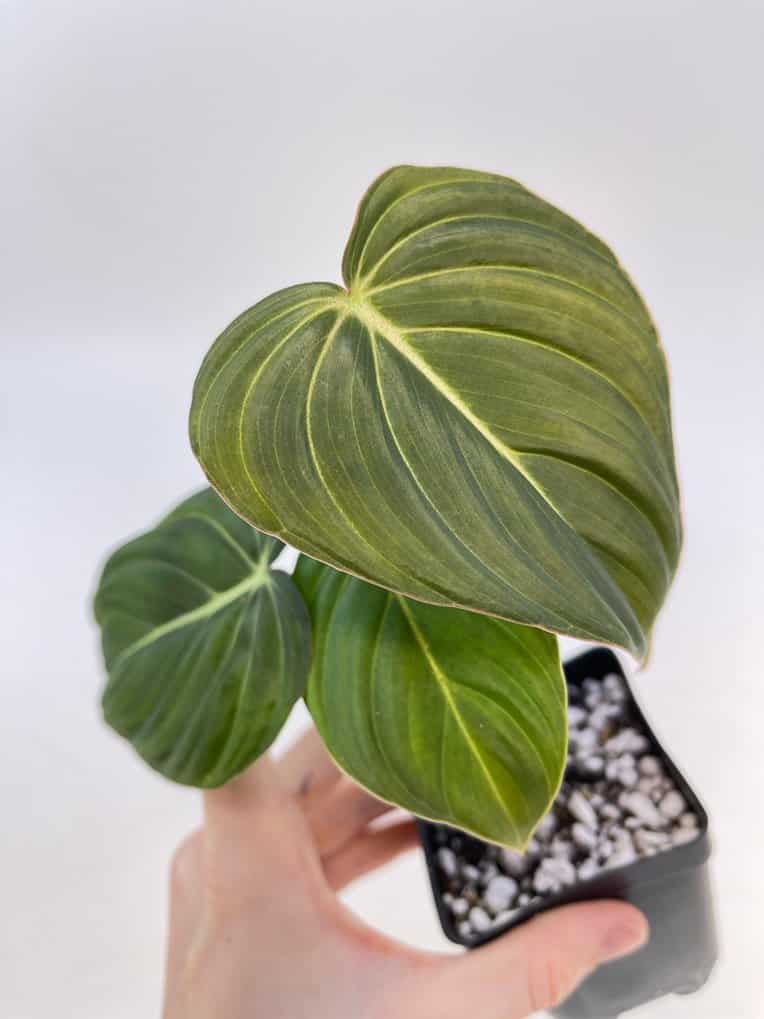
Variegated Philodendron melanochrysum
If you are wondering whether a variegated Philodendron melanochrysum exits, the answer is yes it does. We have seen a few people selling with an aurea (yellowish), pale green, or mint variegations, i.e., sectors, splotches, and speckles.
It goes sell at $2000 to $2500 and is extremely rare. We are unable to comment if it's authentic and whether it will revert or not.

Philodendron melanochrysum vs. micans
Some people often confuse P. melanochrysum and Philodendron micans. But these two plant species have obvious distinctions both in their juvenile and mature form.
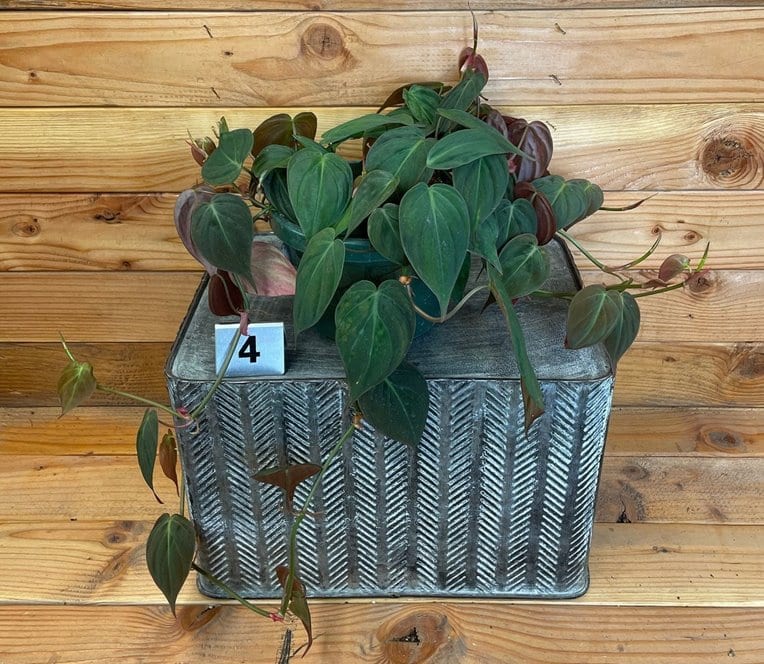
Yes, both have juvenile heart-shaped leaves that may be bronze in appearance. But micans juvenile leaves are velvety while melanochrysum are not. Also, they don’t their underside isn’t reddish-purple or burgundy.
If you look at mature leaves, Philodendron melanochrysum get much larger, i.e., up to 3 feet, are elongated, and much slender. Also, they are velvety dark green to almost black with golden speckles.
On the other hand, Philodendron micans mature leaves are smaller (up to 20 inches), glossy and broader. Also, they hardly occur in home settings.
The last and most obvious distinction is the light green prominent veins that melanochrysum.
Philodendron melanochrysum care
This houseplant is easy to care for and low maintenance. Just ensure a warm, humid area with bright, indirect light. Also, you should water and feed it properly. Don’t forget it needs a place to climb and a well-draining potting mix.
Here is how to care for your Philodendron melanochrysum.
1. USDA hardiness zone
The USDA hardiness zone for P. melanochrysum is 10 or above. Frost or freezing temperature will damage or kill these plants. So, only those in the above zones can confidently grow this ornamental plant outdoors all year round.
2. Philodendron melanochrysum humidity
Whereas they can grow in average household humidity, your black gold Philodendron will appreciate higher humidity, at least 50% or more.
Very low humidity will make leaves have brown tips and edges, curl, or turn yellow. Also, your plant may wilt or droop, grow slowly, etc.
You can temporarily raise humidity by misting your plants. A better way is to move them to a more humid room with enough light, like a bathroom or kitchen, or group your plants.
The other way to raise humidity is using a pebble tray. But if you want to effectively control your humidity, buy a humidifier or grow your plants in a greenhouse cabinet or terrarium.
3. Temperature
Philodendron melanochrysum grows best at 70 to 80 degrees Fahrenheit (21-27°C), but it can tolerate lower temperatures, up to 60°F (15.6°C).
These plants don’t like cold drafts, sudden temperature changes, and heat stress. So, avoid placing them on drafty areas during winter or near air conditioning vents. Also, don’t place your plant near heat emitting vents or sources like radiators, room heating systems, furnaces, etc.
Last but not least, if you have an outdoor Philodendron melanochrysum, move it inside when temperatures fall below 55°F (12.8°C).
Light needs
These plants grow under the canopy of tall rainforest trees in the wild, receiving dappled light. Similarly, provide your melanochrysum with bright, indirect light at home.
Medium, bright indirect light is still ok. But avoid too little light as it will make your plant leggy and have smaller leaves that may look paler or yellow. Use grows lights with about 10000 to 20000 lux like Relassy 15000Lux Sunlike Full Spectrum Grow Lamp.
On the other hand, direct sunlight may cause sunburn characterized by bleached or washed-out leaves and leaf scorch (crispy brown tips, edges, or spots). Also, your plant may wilt or droop, grow slowly, etc.
To avoid sun damage, place your plant at a distance from the window where direct sunlight doesn’t hit your plant. And if outdoor, go for a greenhouse or a shade.
5. Philodendron melanochrysum soil
The best Philodendron melanochrysum soil mix should be airy, well-drained, and high in organic matter. A slightly acid one will do best.
Your black gold Philodendron will grow well in nutrient-rich and well-drained loamy soils, soilless potting mix, or even sphagnum moss alone. You are free to buy an aroid mix from Etsy.com or make yours at home.
Typical mixes at home will have peat moss or coco coir (helps retain moisture), perlite and bark chips (improves drainage and aeration), and compost or worm castings (source of organic matter). You can also add activated charcoal (it helps absorb impurities and holds on to nutrients, among other benefits).
The exact ratio doesn’t matter so long as it is airy, well-drained (holds moisture without being soggy), and high in organic matter. We use about 40% potting mix, 20% peat moss or coco coir, 20% bark chips, 10% perlite, and worm castings. Then we add a handful of horticultural charcoal.
Last but not least, avoid heavy or compacted soils.
6. Watering
They prefer moist soil, never soggy. But you can allow it to slightly dry in-between waterings. So, water your Philodendron melanochrysum when the potting mix’s top 2-3 inches feel dry.
How often to water this aroid will depend on the season, your conditions, pot type or size, potting mix, and many other factors. So, stick your finger, and if it feels dry up to the first knuckle, water your plant. If still wet, wait for a couple more days.
You can also use a soil moisture meter like XLUX and water your plant when it reads below 3 or when it goes to the red zone.
Please, don’t follow a watering schedule and when watering, slowly and evenly water the soil until excess water starts flowing from drainage holes. If you have a saucer or cachepot, discard any they collect.
i. Overwatered Philodendron melanochrysum
These plants are sensitive to overwatering as they cut oxygen from roots and contribute to decay.
Signs include wet potting mix even after not watering for a few days, lower leaves turning yellow, mushy stem base, and a moldy potting mix. Others are wilting that doesn’t improve with watering, brown or black splotches on leaves, etc.
Hold the watering until the top 2-3 inches of the soil dries. Then check if drainage holes are open and amend your potting mix if it doesn’t drain. Also, an oversized pot may be the cause.
ii. Underwatered
Signs your plant is thirsty include dry soil pulled from the pot, wilting and drooping, leaf scorch, curling, and yellowing. Also, plants will grow slowly, and leaves may fall off, and watering improves some of these signs.
7. Feeding
P. melanochrysum is a moderate grower. So, it doesn’t need much feeding, especially if your potting mix is high in organic matter. But to promote a healthy plant with larger lush leaves, consider feeding this houseplant once a month during the growing season only with a balanced, liquid houseplant fertilizer at half strength.
Bonide Bonide Liquid Plant Food 10-10-10 is an excellent pick. Add ⅛ a teaspoon per quart of water and use it to water your plant. Do this twice a month.
If you dont prefer a slow-release, Osmocote Smart-Release Plant Food Plus Outdoor & Indoor. Yes, it is not a balanced formula. But it works wonders too.
Alternatively, go for balanced, slow-release fertilizer. Begin feeding in early spring and follow the manufacturer’s use guidelines.
8. Pruning and grooming
This houseplant doesn’t need much pruning except for cutting any dead, damaged, or diseased leaves with sterilized pruning scissors. But can cut back a few stems (no more than 25%) to control size, shape, and growth in early spring or even summer.
Besides pruning, don’t forget to clean the large adorable leaves when they become dusty or dirty.
9. Repotting
Philodendron melanochrysum repotting is after 2-3 years or when rootbound. You will know that your plant needs repotting the moment roots start growing from drainage holes or spiraling around the pot wall. Don’t wait until your plants start growing slowly, having yellow leaves, wilting, drooping, etc.
Use a pot 2-3 inches wider in diameter and repot, preferably in spring or early summer. It will give your plants to establish again before the non-growing months.
10. Staking or support
As a climbing plant, melanochrysum needs a trellis, moss pole, stake, or a place to climb. So, ensure you provide and train your plant to climb on its support.
Philodendron melanochrysum propagation
The best way of propagating Philodendron melanochrysum is by stem cutting in water or soil. But you can also opt for air layering.
We recommend you do it in spring or early summer. Why? Because it will allow enough time for your cutting to grow before the non-growing seasons.
We will look at soil propagation steps and comment briefly on water propagation and air layering.
1. Soil propagation
Soil propagation takes a shorter time, and your plant will not suffer from much shock when you transplant it. Also, soil offers nutrients. But it is messy, and you cannot see roots growing.
i. What you need
- Nursery pot
- Pruning scissors
- 70 -90% rubbing alcohol (isopropyl alcohol) for sterilizing your scissors
- Well-draining and aerated potting mix
- Transparent plastic bag for locking humidity if you don’t have a greenhouse cabinet, terrarium, or humidifier
- Root hormone – Promotes faster rooting and prevents decay. I recommend a brand like HydroDynamics Clonex Rooting Gel. It is highly rated on various marketplaces and has nutrients to nourish your plant, besides the rooting hormone.
ii. How to propagate Philodendron melanochrysum in soil
- Select a mature stem with at least two nodes and cut it with your sterilized pruning scissors just below the lower node, i.e., at about ¼ an inch below the node. The node is the knobby area where leaves grow and have aerial roots.
- If it has many leaves, remove the lower ones, leaving only the top two. Then apply your rooting hormone from the cut end covering the node you will plant into the soil.
- Fill your nursery pot with your potting mix and pot a hole with a stick or finger. Then plant your Philodendron melanochrysum stem cutting into the hole and press some soil around it to ensure it remains upright.
- Thoroughly water the cutting, ensuring water flowers from drainage holes. Then cover it with your plastic bag, leaving a small breathing space. But ensure leaves don’t touch the plastic bag.
- Move it to a warm area with bright, indirect light.
- After every few days, remove the plastic bag to allow your plant to breathe. Also, mist the soil if it begins to dry. It should remain moist.
After 3-5 weeks, your cutting will have rooted and put on some new growth. You can transplant it to its pot.
2. Water propagation
It allows you to see roots growing and is less messy. But expect more shock when you move your plant to the soil after rooting and slower growth.
Instead of planting your cutting into the soil after step 2 above, dip it in a jar of water, ensuring at least a node is under the water. But don’t immerse leaves. Then, be changing the water after 3-4 days or when the level goes down.
3. Air layering
It involves wrapping moist sphagnum moss with a polythene bag around the nodes on the branches you intend to use for propagation while still attached to the mother plant.
Make sure you poke some holes in your plastic bag to allow air circulation. Also, mist it with sphagnum moss to keep it moist.
Once rooting occurs, you can cut the branch just below the node wrapped with sphagnum moss and transplant your cutting straight to a growing pot.
Problems
Some of the problems you may incur are pests, diseases, leaf discoloration, and curling. Also, your plant may droop or wilt. Let us briefly look at these issues.
1. Pests
Pests are uncommon if you grow these plants indoors. But they can occur especially in red spider mites and scale insects. Other pests are mealybugs, thrips, aphids, thrips, and fungus gnats.
Look at their various signs (webbing, sooty mold, brown, white, black, or yellow spots, slivery stippling, etc.). Also, use a 10X magnifying glass to check on leaves underside or hidden areas for these pests. If you see any, treat them with horticultural oil sprays, insecticidal soaps, or neem oil.
Lastly, if you have fungus gnats, the adult form is harmless. However, their larval stage feeds on roots. Pour a mixture of 1 part of hydrogen peroxide to 4 parts of water into the root areas.
2. Diseases
Fungal and bacterial leaf spots, rusts, or blights are rare. But if they occur, you will notice dry or water-soaked brown to black lesions. Some may have a yellow halo.
Immediately cut the affected part. Afterward, use If you have a fungal infection, use a fungicide. Bacterial diseases don’t have a chemical cure bactericide with copper compounds may help prevent spread.
Lastly, practice proper sanitation like hand washing and sterilizing gardening tools. Also, isolate new plants as you see if they are disease-free.
3. Root rot
Root rot is a prevalent problem for those that overwater their black gold Philodendron or whose potting mix doesn’t drain or pots don’t have drainage holes.
Signs include yellow or brown leaves, wilting, drooping, stunted growth, mushy stem base, and mushy black or brown roots.
You can only save this Philodendron if the decay hasn’t eaten the entire root ball. Just repot the plant cutting off any decayed bits. You can then apply a fungicide before moving it to a fresh potting mix.
4. Other problems
| Problem | Most likely cause(s) | Other possible cause |
| Leaves turning yellow | Overwatering | Underwatering, nutritional deficiency, too little light, low humidity, rootbound, and repotting shock |
| Brown tips and edges | Sunburn, heat stress, underwatering, low humidity, or too much light | Fertilizer burns, rootbound, water quality, and repotting shock |
| Brown spots and splotches | Overwatering, low humidity, and sunburn | Pests, diseases, cold drafts, sunburn |
| Black spots | Disease and pests | Overwatering, cold damage, and water quality |
| Leaves curling | Underwatering, too much light, low humidity, and heat stress | Pests, overwatering, transplant shock, rootbound, and overfeeding |
| Drooping or wilting | Underwatering, low humidity, too much light, and heat stress | Root rot, pests, transplant shock, overfeeding, rootbound, and overwatering |
Where to find Philodendron melanochrysum on sale
The best place to find Philodendron melanochrysum on sale is Etsy.com. This marketplace has many vendors from all over the world. So, not only people in the US can buy from Etsy but those from the UK, Australia, Canada, New Zealand, etc.
eBay is the Etsy.com alternative that uses a bidding system. It is equally good, and you can buy this plant from anywhere in the world.
If you still haven’t found it, try Facebook and Instagram. Here, you will also find many vendors. Other places to try are Logee’s, NSE Tropicals, Ecuagenera, Peace, Love & Happiness, etc.
Last but not least, google “Philodendron melanochrysum for sale” to get other vendors near your location.
Frequently asked questions (FAQs)
Yes. Philodendron melanochrysum rare is a rare, uncommon, and costly houseplant. You are unlikely to find it at any of your local tropical houseplant vendors or big box stores.
Philodendron melanochrysum price ranges from $50 to $150 for a root to an established plant in most marketplaces. Unrooted stem cuttings go for $20 to $50, making this plant way more expensive compared to an average houseplant cost.
Philodendron melanochrysum is expensive because it is rare (not readily available), creating a higher demand than supply. The large horticultural growers and big boxes don’t sell it. Also, being a moderate grower takes longer to grow or propagate.

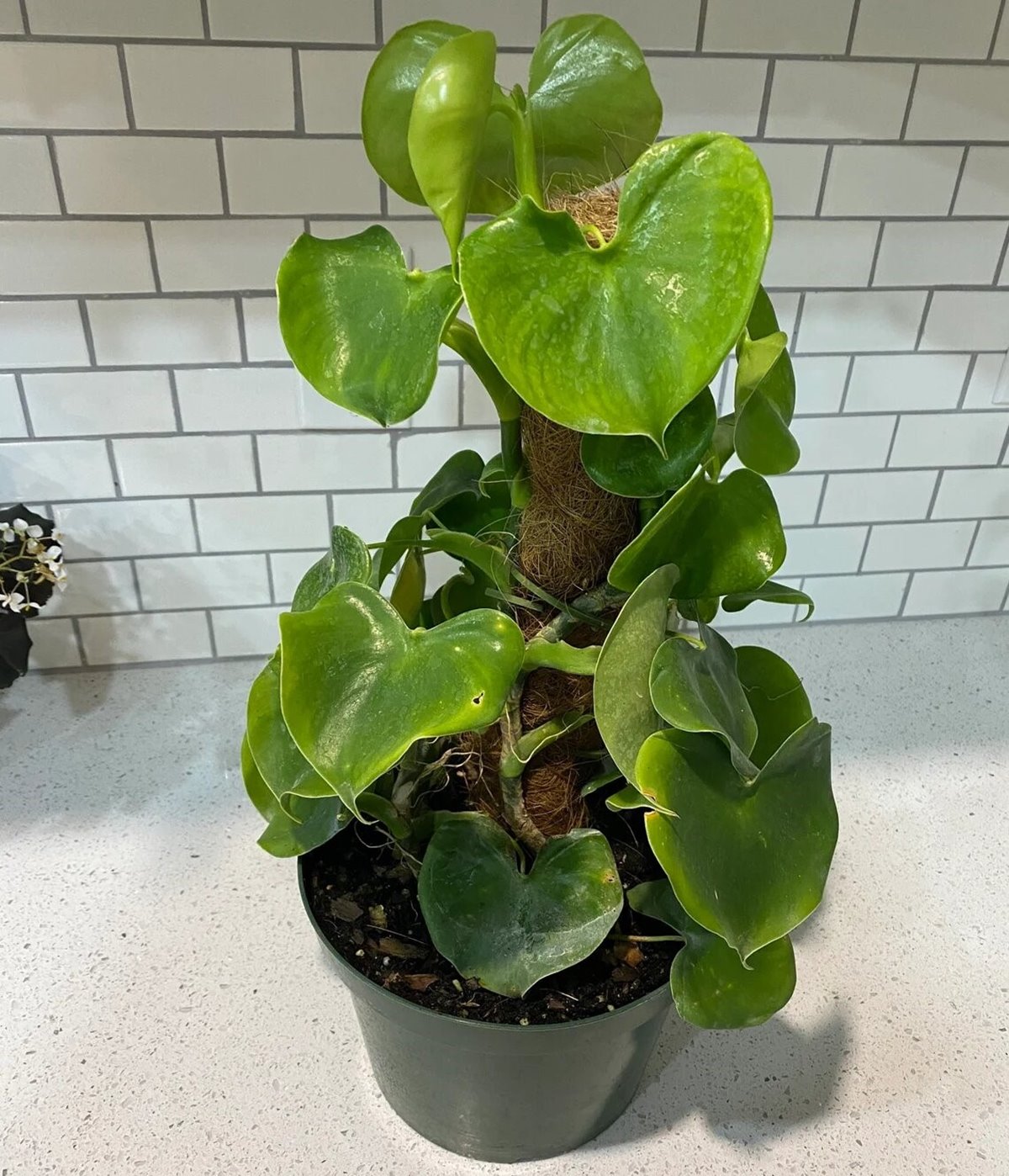
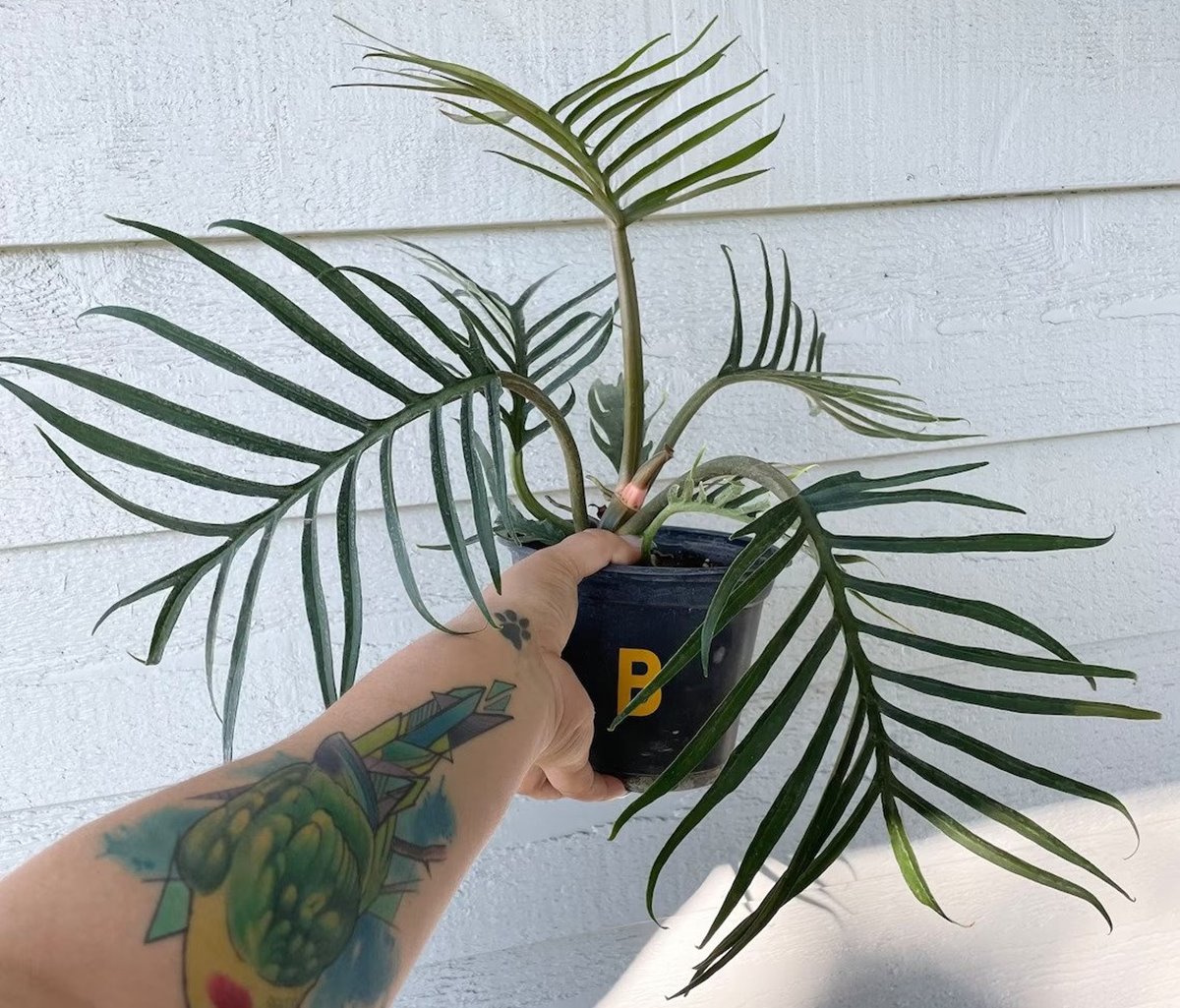
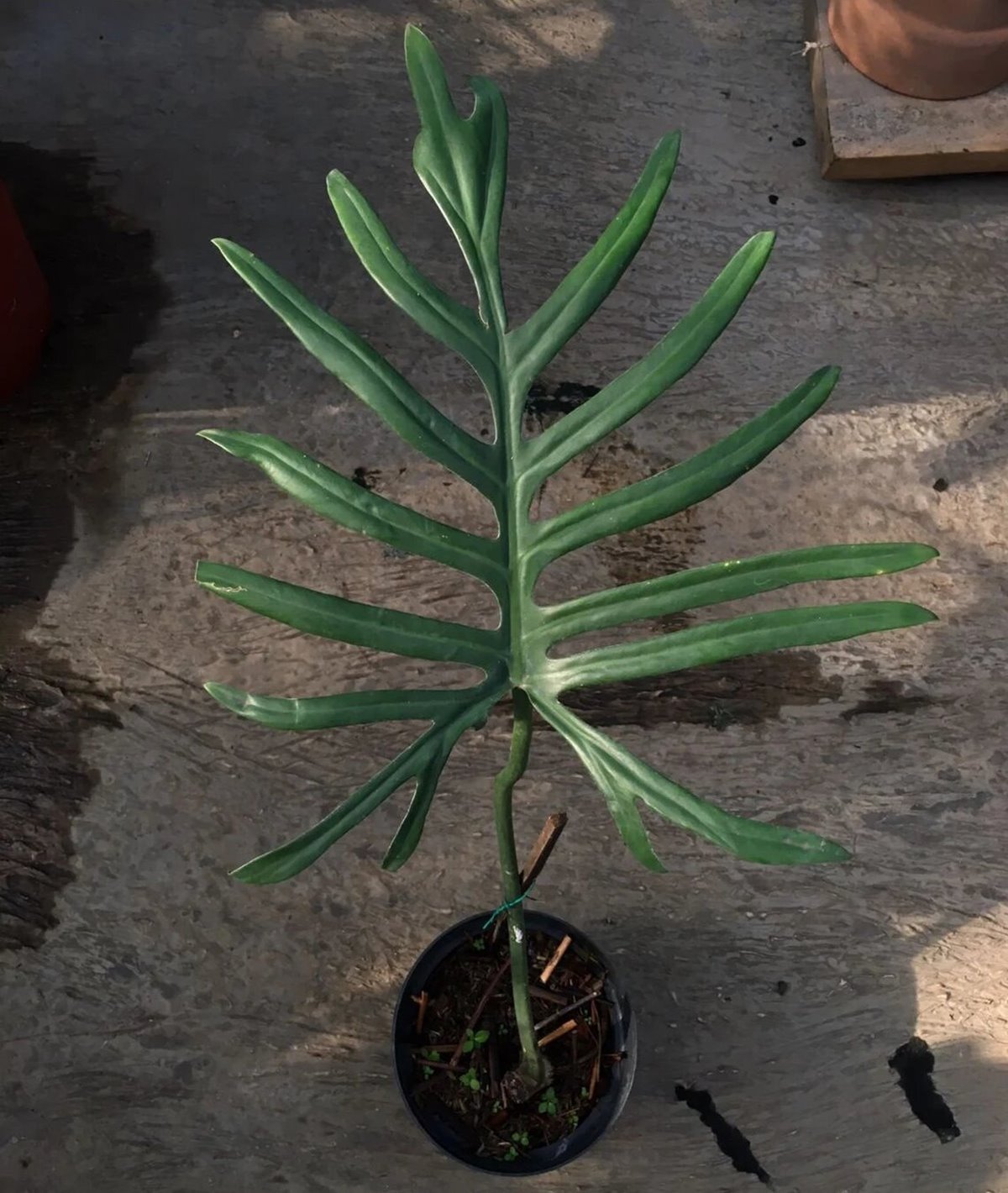

Plantipus
thanks for the article about Philodendron Melanochrysum.